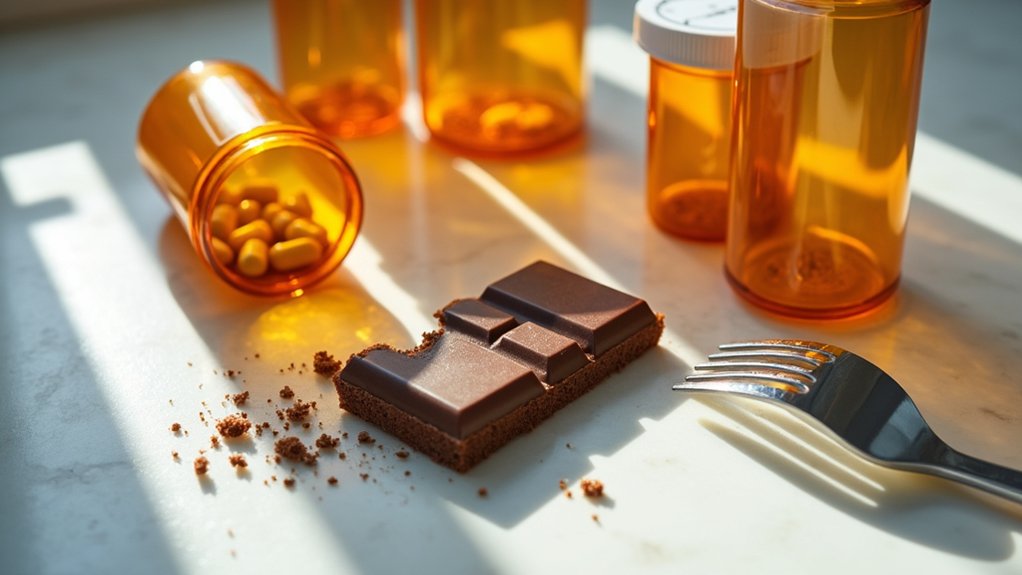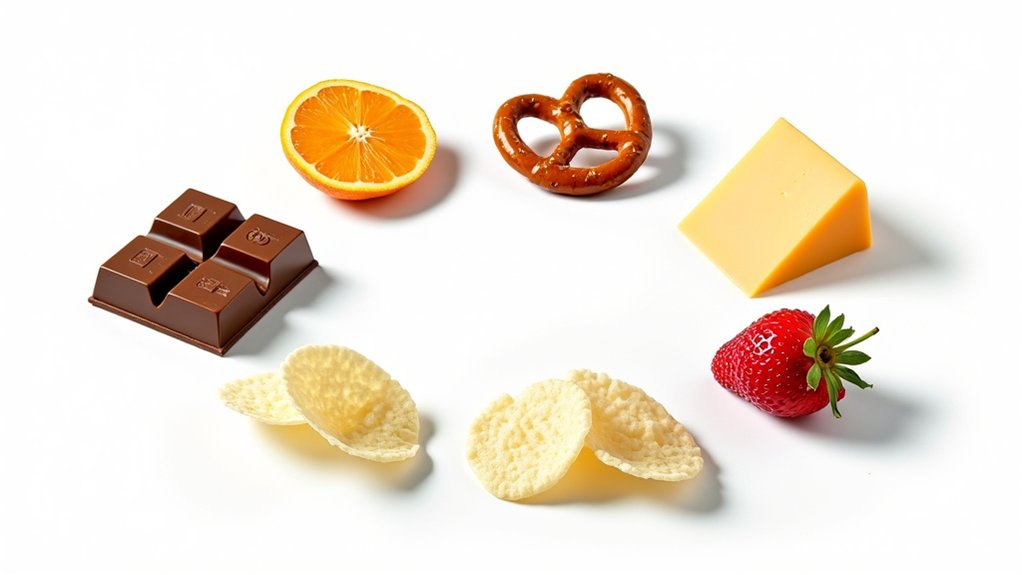Common signs of an alcoholic face include persistent facial redness, especially across the nose and cheeks, with visible broken capillaries and spider angiomas. You’ll notice characteristic puffy features, particularly around the eyes and face, often worse in mornings. Look for yellowing skin tone (jaundice), premature aging with excessive wrinkles, and dry, leathery skin texture. These physical manifestations typically appear alongside bloodshot eyes and general dullness. The progression of these symptoms can reveal the severity of alcohol dependency.
Facial Redness and Broken Capillaries
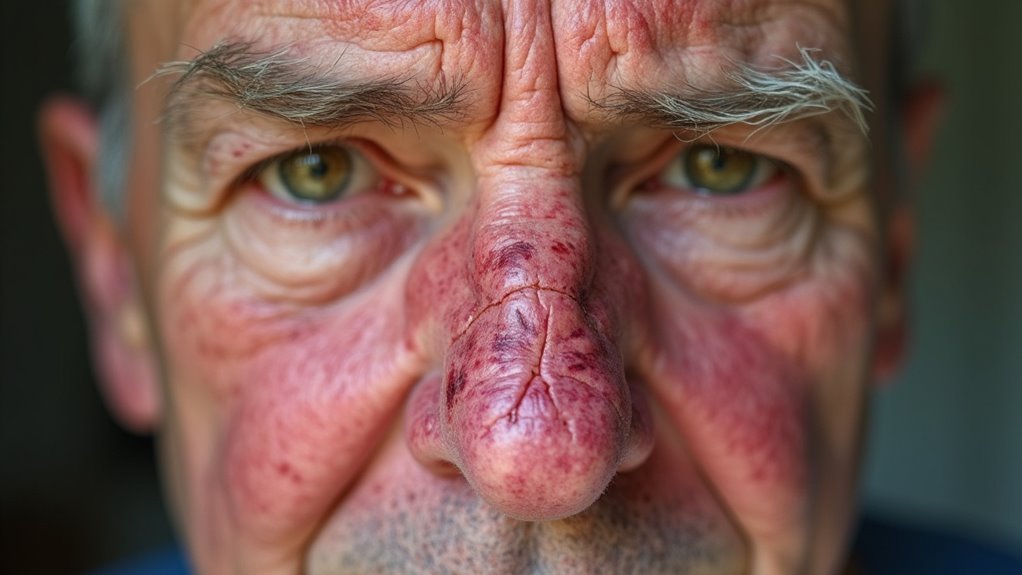
Persistent redness across the cheeks, nose, and facial skin represents one of the earliest visible indicators of alcohol abuse. This facial flushing occurs because alcohol expands your blood vessels, allowing more blood to flow near the skin’s surface. Over time, this repeated dilation damages capillaries, creating a permanent network of tiny broken blood vessels visible as spider-like patterns, particularly around the nose and cheeks.
The chronic redness typically worsens after drinking episodes but gradually becomes a permanent feature with continued alcohol misuse. You’ll notice this redness differs from normal blushing it doesn’t fade quickly and often has a distinctive pattern concentrated in the mid-face region. In advanced cases, the skin may appear purplish or slightly swollen, especially in the morning. These vascular changes can persist even during periods of sobriety.
Spider Angiomas and Vascular Changes
Spider angiomas represent a specific and telling vascular abnormality that often appears on the faces of chronic alcohol users. You’ll recognize these as small, red lesions with thin blood vessels radiating outward from a central point, resembling a spider’s web. They typically appear on the cheeks, nose, and around the mouth.
The spider angiomas formation occurs because alcohol damages your liver’s ability to process estrogen, leading to increased hormone levels that dilate blood vessels. Prolonged drinking impairs vascular health impacts beyond just facial appearance these visible markers actually indicate internal damage.
When examining someone’s face, look for clusters of these spider-like formations, especially in the facial triangle from the bridge of the nose to the corners of the mouth. Their presence, particularly in multiples, strongly suggests chronic alcohol consumption.
Puffy Features and Facial Bloating
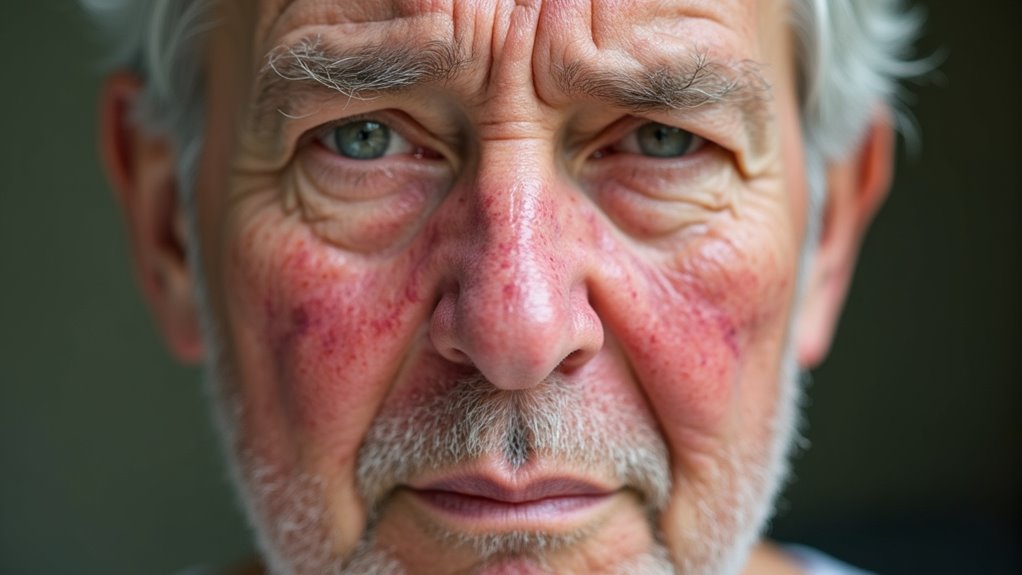
Alcoholism can cause significant fluid retention in the face, creating a characteristic puffiness that’s often most pronounced in the morning hours before gradually subsiding. You’ll notice this alcohol-induced facial bloating particularly around the eyes, cheeks, and jawline, where the skin appears swollen and taut due to inflammatory responses and disrupted fluid balance. While similar facial puffiness can result from other conditions like thyroid disorders or allergies, alcohol-related bloating typically occurs with supplementary signs like facial redness and gradually worsens with continued heavy drinking.
Fluid Retention Mechanisms
When excessive alcohol consumption becomes chronic, it triggers several physiological mechanisms that lead to fluid retention in facial tissues. Alcohol disrupts your body’s normal fluid balance by inhibiting antidiuretic hormone production, initially causing dehydration but later promoting water retention when consumed regularly. Your kidneys respond by conserving more sodium and water, resulting in visible facial edema.
Additionally, alcohol’s inflammatory effects damage small blood vessels, increasing their permeability and allowing fluid to leak into surrounding tissues. The liver, when compromised by regular drinking, fails to produce sufficient albumin a protein essential for edema management. This protein deficiency further contributes to fluid accumulation in facial areas where skin is thin and elastic, particularly around the eyes and cheeks. The combination of these mechanisms creates the characteristic puffy appearance associated with chronic alcohol use.
Morning vs. Evening Puffiness
Distinguishing between normal morning facial puffiness and alcohol-induced bloating requires careful observation of both timing and persistence patterns. While many people experience mild morning swelling that dissipates within hours after waking, alcoholic facial bloating follows a different trajectory.
| Timing | Normal Puffiness | Alcoholic Puffiness |
|---|---|---|
| Morning | Mild, resolves quickly | Pronounced, persists longer |
| Midday | Typically absent | May remain visible |
| Evening | Rarely present | Can worsen with drinking |
| Overnight | Develops during sleep | Worsens with continued use |
You’ll notice alcoholic facial bloating tends to maintain consistency throughout the day. Evening puffiness particularly indicates problematic drinking, as non-alcoholic facial swelling typically doesn’t develop later in the day unless other medical conditions are present. The persistence of puffiness regardless of time is a key differentiator.
Distinguishing Other Causes
Although facial puffiness and bloating can suggest alcohol misuse, several medical conditions may produce similar appearances that shouldn’t be confused with alcoholic facies. Hypothyroidism often causes facial swelling, while kidney disease frequently leads to fluid retention that affects facial tissues. Cushing’s syndrome creates distinctive moon-shaped facial fullness that might resemble alcoholic bloating.
You’ll need to evaluate genetic predispositions that naturally create fuller faces in certain individuals or family lines. Some medications, particularly corticosteroids and certain antidepressants, can cause facial edema mimicking alcohol-induced changes. Stress-related changes also play a significant role, as chronic stress triggers cortisol production that redistributes fat to the face. Allergic reactions might temporarily produce swelling that resembles alcohol-related inflammation, especially around the eyes and cheeks.
Jaundice and Yellowing Skin Tone
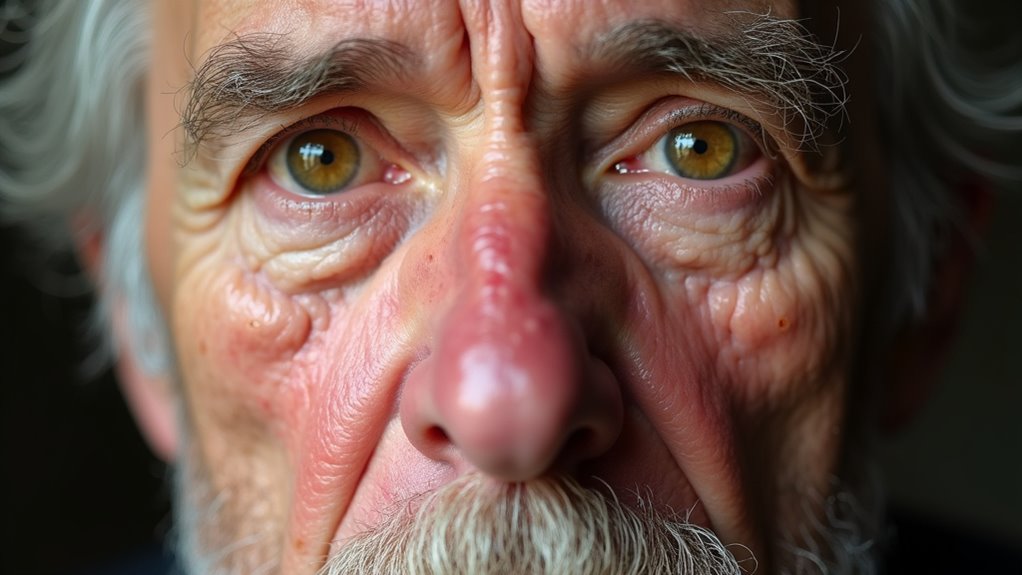
Jaundice, characterized by yellowing of the skin and whites of the eyes, often indicates liver damage from prolonged alcohol abuse. You’ll notice this discoloration most prominently in areas with thin skin such as the face, particularly around the eyes, mouth, and nasal folds. Early detection of these yellow tones can signal the need for immediate medical intervention, as they represent the liver’s diminishing capacity to process bilirubin, a breakdown product of red blood cells.
Liver Damage Indicators
One of the most definitive physical manifestations of severe alcoholism appears when the liver sustains significant damage: jaundice. This yellowing of the skin and whites of the eyes occurs when the liver can’t properly filter bilirubin from the bloodstream. In advanced liver cirrhosis symptoms, you’ll notice this discoloration most prominently in the face, particularly around the eyes and mouth.
Beyond jaundice, watch for hepatic encephalopathy signs including confusion, personality changes, and deteriorating mental function. Other facial indicators of liver damage include spider angiomas (small, spider-like blood vessels visible on the skin), palmar erythema (reddening of the palms), and facial swelling due to fluid retention. These physical changes typically develop gradually as the liver’s function continues to decline from prolonged alcohol abuse.
Detecting Early Signs
While the later stages of alcoholism present obvious physical markers, identifying jaundice and yellowing skin tone early can be essential for intervention before liver damage becomes severe. You’ll initially notice subtle yellowing in the sclera (whites of the eyes), followed by skin discoloration around the face, particularly near the nose and cheeks.
| Early Sign | What to Look For | Significance |
|---|---|---|
| Scleral yellowing | Faint yellow tint in eye whites | Primary detectable sign of bilirubin buildup |
| Facial discoloration | Yellowish hue around nose/mouth | Indicates progressing liver dysfunction |
| Skin tone changes | General dullness or yellow cast | Suggests need for immediate medical evaluation |
Early intervention through complete alcohol cessation and lifestyle modifications can reverse these symptoms in many cases. Don’t wait for advanced signs subtle yellowing warrants immediate medical attention.
Dry, Wrinkled, and Prematurely Aged Skin
The excessive consumption of alcohol gradually dehydrates the skin, leading to a characteristic appearance of premature maturation. You’ll notice a loss of elasticity and deepening of fine lines, particularly around the eyes and mouth. Alcohol depletes the body’s hydration levels, causing skin to appear dull, rough, and paper-thin.
When examining potential alcoholic facial features, look for skin that appears older than the person’s chronological timeline. Normal skincare routines become ineffective as alcohol inhibits vitamin A absorption, essential for cell renewal. The skin may develop a grayish tinge and increased sagging, especially along the jawline and neck. These changes often develop subtly over months or years, becoming more pronounced with continued heavy drinking, and can persist long after sobriety begins.
The Eyes: Redness, Puffiness, and Sunken Appearance
Moving from skin’s surface changes to facial features, characteristic eye alterations often reveal chronic alcohol consumption patterns. You’ll notice persistent redness due to expanded blood vessels, a direct result of alcohol’s inflammatory effects on eye health. The whites appear bloodshot, sometimes with a yellowish tinge indicating potential liver dysfunction.
Puffiness beneath and around the eyes stems from alcohol’s hydration impact, causing fluid retention and inflammation in surrounding tissues. This same dehydration paradoxically creates a sunken appearance as the eye orbits lose volume over time. Dark circles become more pronounced due to compromised circulation and nutrient deficiencies common in heavy drinkers.
These ocular changes typically worsen during active drinking periods and may temporarily improve with sobriety, though long-term damage can become permanent without intervention.
Dehydration Markers and Skin Texture Changes
Chronic alcohol consumption dramatically alters skin texture through persistent dehydration, creating distinctive markers you’ll recognize in alcoholic faces. Alcohol’s diuretic effect depletes the body’s water content, directly impacting skin appearance and elasticity.
Look for these telltale dehydration effects:
- Premature fine lines – especially around the eyes and mouth, appearing deeper than expected for one’s maturity
- Decreased skin elasticity – skin that doesn’t “bounce back” when pinched, indicating collagen breakdown
- Rough, flaky patches – irregular texture reflecting the body’s inability to maintain proper hydration
- Dull, lifeless complexion – absence of healthy glow due to impaired circulation and chronic dehydration
These texture changes develop gradually but become increasingly prominent with continued excessive drinking, making the alcoholic face increasingly recognizable.
Physical Manifestations of Nutritional Deficiencies
Chronic alcohol misuse impairs your body’s ability to absorb essential nutrients, resulting in deficiencies that manifest visibly on the face. You’ll notice eye abnormalities like yellowing sclera or bloodshot appearance, alongside skin issues including angular cheilitis and seborrheic dermatitis from B vitamin deficiencies and zinc depletion. These nutritional shortfalls contribute to a distinct appearance that includes premature aging, flaky skin patches, and a characteristic pallor that becomes increasingly pronounced with continued alcohol abuse.
Eye and Skin Signs
The physical manifestations of nutritional deficiencies often appear prominently on an alcoholic’s face, particularly in the eyes and skin. Chronic alcohol consumption depletes essential nutrients that maintain eye health and skin hydration, resulting in distinctive visible changes.
Look for these telltale signs:
- Jaundice – Yellowing of the whites of the eyes and skin due to liver dysfunction and raised bilirubin levels
- Spider angiomas – Small, spider-like blood vessels visible on the skin, especially on the cheeks and nose
- Conjunctival redness – Bloodshot eyes from vitamin B1 deficiency and chronic dehydration
- Parched skin texture – Premature aging with deep wrinkles and a leathery appearance from depleted collagen and poor skin hydration
These visual indicators develop gradually but become increasingly apparent as alcohol abuse continues, reflecting the body’s compromised nutritional status.
Vitamin B Complex Deficits
Because alcohol severely impairs the body’s ability to absorb and utilize B vitamins, alcoholics often display distinctive facial features stemming from these critical nutritional deficiencies. You’ll notice a characteristically smooth, beefy-red tongue (glossitis) resulting from vitamin B2 and B3 deficiencies. The corners of the mouth may develop painful cracks or inflammation (angular cheilitis) due to riboflavin shortages. Thiamine deficiency manifests as facial puffiness and drooping eyelids, while inadequate B6 causes seborrheic dermatitis around the nose and mouth.
These indicators worsen with chronic drinking as vitamin absorption continues to deteriorate. Without proper nutritional support, these features become more pronounced and potentially permanent. Early intervention with B-complex supplements can reverse many of these physical manifestations, though this requires significant reduction or cessation of alcohol consumption.
Zinc Depletion Effects
Alongside B vitamin deficiencies, prolonged alcohol consumption greatly depletes zinc stores in the body, creating distinctive facial characteristics you can identify in chronic drinkers. Zinc depletion manifests visibly on the face and can worsen with continued alcohol use.
Look for these telltale signs of zinc deficiency in alcoholics:
- White spots on fingernails that accompany facial changes
- Persistent acne-like lesions, particularly around the mouth and chin
- Slow-healing facial wounds or persistent redness
- Premature wrinkling and loss of skin elasticity
Early intervention with zinc supplementation benefits include improved wound healing and skin integrity. Encouraging zinc-rich foods such as oysters, red meat, poultry, and legumes can help reverse some visible symptoms, though alcoholics must address the underlying addiction for significant improvement.
Distinguishing Alcoholic Face From Other Conditions
Many medical conditions can mimic the physical characteristics of alcoholic face, making accurate identification challenging without proper medical context. Rosacea, lupus, and certain vitamin deficiencies often present with similar facial redness and swelling that you might misinterpret as signs of alcohol abuse.
When conducting facial symmetry analysis, you’ll notice alcoholic faces typically display distinctive patterns of fluid retention and vascular changes that differ from other conditions. While rosacea concentrates redness centrally, alcohol consumption effects tend to cause more diffuse redness with pronounced spider veins (telangiectasias) and a characteristic puffy appearance around the eyes and cheeks. Furthermore, liver dysfunction from prolonged drinking creates a yellowish tinge that’s absent in most skin conditions. Consider these differences alongside behavioral cues rather than making assumptions based on appearance alone.
Early Warning Signs and Progression of Facial Changes
The initial manifestations of alcohol’s impact on facial appearance often precede full-blown alcoholic facies by months or years. You’ll notice subtle changes that gradually become more pronounced with continued excessive drinking. These early warning signs develop on a timeline that correlates with alcoholic behavior patterns and drinking frequency.
Subtle facial changes from alcohol emerge gradually, signaling potential problems long before characteristic alcoholic features fully develop.
- Mild facial flushing – Initially temporary after drinking but eventually becomes permanent as blood vessels dilate
- Subtly puffy features – Particularly noticeable around the eyes and cheeks before progressing to general facial bloating
- Changes in facial expressions – Decreased muscle tone creating a slightly drooping appearance
- Dull complexion – Skin appears less vibrant with diminished elasticity before developing the characteristic redness
Early intervention at these stages can prevent progression to more permanent and distinguishable alcoholic facial features.
Frequently Asked Questions
How Quickly Do Facial Changes Appear After Someone Develops Alcoholism?
You’ll notice facial changes within months to years of heavy drinking. Early signs like facial redness and puffiness can appear after just weeks of excessive alcohol consumption. More significant facial aging, including broken capillaries, jaundice, and pronounced wrinkles, typically develops after years of alcoholism. The timeline varies based on your drinking patterns, genetic factors, nutritional status, and general health. These changes often progress gradually but can accelerate with continued heavy drinking.
Can Alcoholic Facial Features Completely Reverse After Achieving Sobriety?
Yes, alcoholic facial features can reverse considerably with sobriety. Your recovery timeline depends on several factors including duration of alcohol abuse and individual physiology. Most people notice reduced facial redness and puffiness within weeks. Complete reversal of more severe changes like broken capillaries may take months or years. Lifestyle changes including proper hydration, nutrition, exercise, and skincare accelerate healing. Some vascular damage might remain permanent, but your general appearance typically improves dramatically with sustained sobriety.
Do Genetics Influence How Alcohol Affects Someone’s Facial Appearance?
Yes, your genetic predisposition greatly influences how alcohol affects your facial appearance. Your facial genetics determine enzyme efficiency for alcohol metabolism, with variations potentially causing faster flushing, more pronounced inflammation, or greater fluid retention. These genetic factors explain why some heavy drinkers develop more visible facial changes than others consuming similar amounts. Furthermore, hereditary collagen production capabilities impact how quickly your skin recovers from alcohol-induced damage, even after achieving sobriety.
Are There Differences in Alcoholic Facial Features Between Men and Women?
Yes, you’ll notice gender differences in alcohol-related facial features between men and women. Women typically develop facial flushing and broken capillaries earlier due to lower alcohol dehydrogenase levels. Men often present with more pronounced rhinophyma (bulbous nose) and facial asymmetry. Women may experience more rapid onset of facial puffiness and skin damage, while men frequently develop deeper nasolabial folds and more severe spider angiomas. Hormonal variations contribute to these distinct manifestations of chronic alcohol consumption.
Can Medications or Treatments Reduce the Visible Signs of Alcoholic Face?
Yes, several treatments can reduce visible signs of alcohol-related facial changes. You’ll find medication effectiveness varies with the specific feature being treated. For rosacea, topical metronidazole and oral antibiotics often help. Treatment options for facial swelling include diuretics that reduce fluid retention. Vitamin supplements, particularly B vitamins, can improve skin health. Specialized skincare with retinoids may reduce broken capillaries and improve skin tone. Complete alcohol cessation remains the most effective approach for long-term facial recovery.


